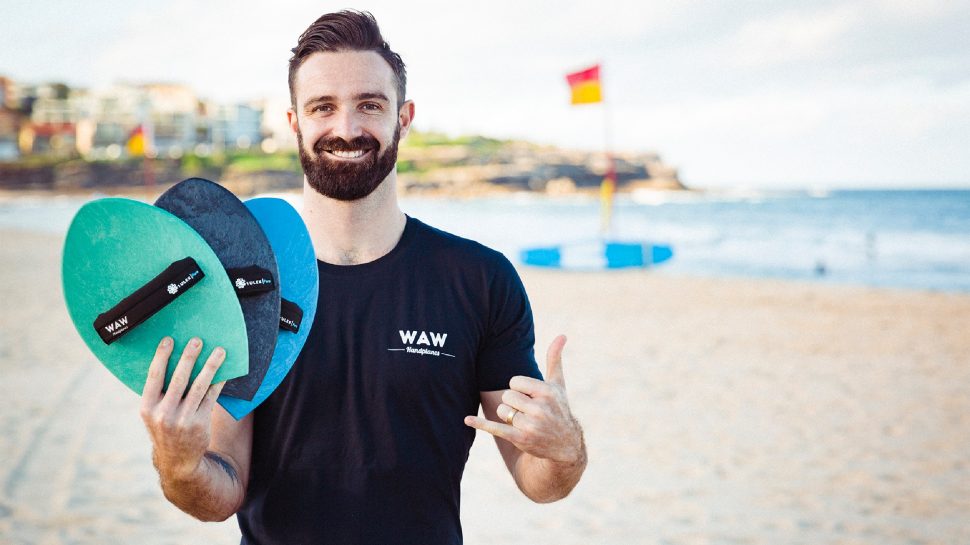How to build your online community through social media
How do you find your online tribe? Rikki Gilbey, Founder of WAW Handplanes, shares how he built a community of bodysurfing enthusiasts on Instagram that brings people together #IRL.

Rikki Gilbey, Founder of WAW Handplanes.
Key points
- Using social media for your business is a cost-effective way to engage with your customers.
- Build a community on social media around your area of expertise or interest.
- Choose your social media channels to suit your audience—you don’t have to use them all.
Riding the social media wave
As a small business owner, you probably don’t have the time or money to invest in fancy advertising to reach new customers. But how can you build a loyal community of advocates who will help spread the word for you? Two words: social media.
In 2023, over 8 in 10 Australians were active social media users, with the average person spending over two hours every day scrolling through their social feeds. These users weren’t there just to catch up on friends’ news or watch reels, either. Almost 1 in 3 Australians visit social networks to research brands and products, with the number growing year-on-year.
No wonder social media is seen as such an invaluable tool for small businesses to reach new customers and build stronger relationships with existing ones. Question is, how do you find your tribe online, gain their trust, and get them to help you grow?
We spoke to the founder of WAW Handplanes, Rikki Gilbey, about how he not only grew his Instagram account, but also built a powerful #IRL community. Here are his tips for social success.
1. Find your people
Let’s face it. Bodysurfing is a niche sport. Rikki came to it by accident when a work mate invited him out for a bash in the waves. “I thought bodysurfing was something you do when you’re at the beach having a bit of fun in the white water,” he says.
“But I’ll never forget the very first wave I caught using a bodysurfing handplane,” says Rikki.
A handplane is worn on a body surfer’s leading hand and helps them to move faster whilst riding wave.
“I rode it from out the back all the way into the beach, where I got wrapped up in a fun little barrel right on the sand. I came up covered in frothy water and sand with the biggest smile on my face.”
It was a feeling he held onto. One that drove him to start making his own handplanes from reclaimed timber, and then scaling up to make them out of reclaimed ocean plastics.
Today, WAW Handplanes is an award-winning Australian small business success story—but to build his business, Rikki first had to had to find his customers. To do this, he turned to social media. And one channel in particular proved perfect.
“I quickly realised that bodysurfing didn’t have much of a community. By its nature, a lot of people who bodysurf do it by themselves,” says Rikki. “Through Instagram, we managed to unite a lot of people by simply posting bodysurfing content. Instagram was a place where people could engage with our content and then meet all these other people.”
2. Bring them together
While social media is an incredibly powerful marketing tool, nothing beats face-to-face interactions. Recognising this, Rikki decided to make the most of all the followers he’d built up on Instagram.
“We started creating in-person gatherings. We’d hold a bodysurfing camping trip in NSW every year, where 50 or 60 bodysurfers from around the country would come and camp with us for a weekend of bodysurfing,” he says.
“Off the back of that, I started the Australian Bodysurfing Classic in 2016, which is the Australian bodysurfing championships. From that, around 30 different bodysurfing clubs have been established around the country. It has created this community of bodysurfers, and it all stemmed from Instagram. That’s how powerful it is.”
3. Know your channel
For Rikki’s business, Instagram has been the perfect platform. Thanks to some incredible footage of bodysurfers in action, it has really united the bodysurfing community. WAW Handplanes gave Facebook a go early on, but realised it wasn’t quite right for their target demographic. “We still use Facebook for digital advertising, but we’re not very active on the platform,” says Rikki.
The business has recently started using TikTok, which is helping to reach a broader spectrum of people thanks to the highly engaging user-generated content coming from bodysurfing pros. “On TikTok, we get a lot of impressions and a lot of people viewing our product, but we don’t have the same level of community-building that we have from Instagram.”
4. Build your online persona
Rikki’s story, and the story behind WAW Handplanes, has helped build a loyal and passionate community on social media. Your business can, too. It’s all about defining your personality and building a strong online persona around it.
Here are a few tips to help you shine online:
• Invest in face time: Nothing beats face-to-face interaction so when you meet new or potential customers, tell them about your online community. Once they get to know and like you in real life, they may just become your best brand advocates.
- Be human: You want people to care about you and your brand, so an empathetic, human voice that people can connect with is just as important as engaging content.
- Serve your community: Be generous about sharing your expertise. If you’re a craft maker, you could make a how-to video. Or if you run a restaurant, share a not-so-secret recipe.
- Be present, be consistent: Actively listen to your audience and understand their interests. Be consistent with your posting but don’t post so much that you can’t keep up with engagement and feedback. It’s always about quality over quantity.
- Outline a community policy: It’s beneficial to have a community policy that outlines the behaviour you expect from users and vice versa. If you’re a family brand, for example, then make it clear that you will only engage in respectful conversation.
As your online community grows, so too will the benefits to your business. Think greater brand awareness, customer loyalty and, ultimately, increased sales. Just like WAW Handplanes, you can turn social media into a powerful platform for business growth.
Ready to elevate your business in 2024?
Ready to elevate your business in 2024?
The free 2024 Inside Australian Online Shopping: eCommerce Industry Report is now available. Uncover valuable insights from the previous year and stay ahead of the game.


